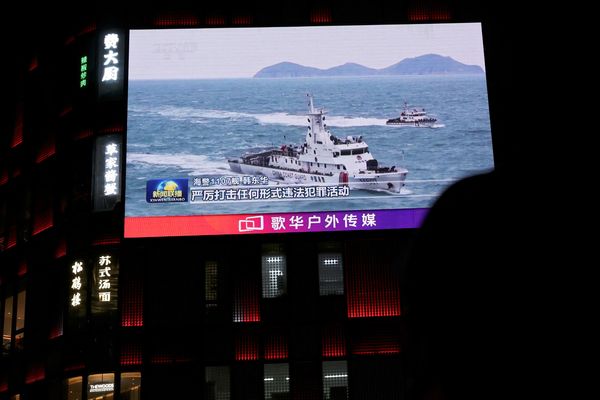For more than half a century he held the title Prince of Wales, but in autumnal sunshine on Friday, Charles was helicoptered across the Severn from his Gloucestershire country home for his first visit to the country as King.
The reaction of the crowds that lined the streets of the Welsh capital was largely warm, but he was booed as he entered Cardiff Castle by anti-monarchy protesters and there were small demonstrations at Llandaff Cathedral and the Senedd building.
Charles is not universally popular in Wales and his announcement that William is to be made Prince of Wales has been greeted with anger by many. Some see it as a symbol of English oppression over Wales.
Protesting outside the cathedral, where Charles and the Queen Consort attended a service of prayer and reflection with the prime minister, Liz Truss, was Laura Thomas-Walters, 29, a conservation scientist.
She said: “In the 21st century in a democratic country, an unelected head of state has no place. It’s an antiquated system of class oppression and class inequalities, which is especially heinous at a time when inequalities are rising so fast.
“Many people this winter are going to pay their heating bills but we’re going to pay millions for a coronation, a funeral, changing stamps and Charles isn’t going to pay a penny in inheritance tax. I don’t think the Prince of Wales title should exist. If it did, it should belong to a Welsh person.”
Inside the cathedral, the archbishop of Wales, Andrew John, said the Queen had been able to bring people together in difficult circumstances, such as her visit to the site of the 1966 Aberfan disaster, where 144 people lost their lives when a coal tip collapsed on a primary school. Members of the Aberfan Wives group were among invited guests at a reception for the King at Cardiff Castle later.
The Welsh language was very much front and centre at the service with the first minister, Mark Drakeford, reading from the first book of Kings in Welsh. Camilla wore a silver leek brooch given by the Queen.
After the service, Charles and Camilla went on a walk around the Cathedral Green.
Susie Eardley, who gave the King a red rose, explained: “He gave me a rose in 1983 when he visited a conservation project at Dunraven Castle in south Wales. He had a red rose in his lapel and pinned it to my overalls. I thought I’d give him a rose today.”
Lynda Fowler was beside herself with joy at her meeting with the King. She said: “He touched my veteran’s badge. I was in the RAF. I can’t wait to tell my grandchildren, they’ll be so excited.”
A man shouted: “We pay £100m a year for you, and for what?”
Queen Elizabeth II’s children were set to pay their respects at their mother’s coffin ahead of her state funeral at a Vigil of the Princes in Westminster Hall on Friday evening.
The King, Princess Royal, Duke of York and Earl of Wessex were to stand at four corners of the catafalque, a tribute they first mounted at St Giles’s Cathedral in Edinburgh.
On Saturday evening the Queen’s eight grandchildren will stand vigil beside her coffin.
As non-working members of the royal family, both Prince Andrew and Prince Harry have been permitted to wear uniforms for the solemn vigils at the King’s request.
Charles was also meeting with faith leaders at Buckingham Palace on Friday.
The Prince and Princess of Wales visited Army Training Centre Pirbright in Surrey to meet troops from the Commonwealth who are to participate in the Queen’s state funeral.
Charles visit to Wales coincided with Owain Glyndŵr day, which celebrates the life and legacy of the last Welsh Prince of Wales. Llandaff Cathedral was damaged in Glyndŵr’s 15th-century fight against the English.
At the Senedd – the Welsh parliament – Charles said his mother had taken great pride in the country’s achievements and felt its sorrow keenly. He said: “Through all the years of her reign, the land of Wales could not be closer to my mother’s heart.”
Addressing the Senedd in both Welsh and English, the King said his mother had been immensely proud of Wales and was devoted to the country. Charles’s attitude to the Senedd is important. The Queen was a friend to the devolved institution and his support – especially given that the English Tory establishment is often seen as dismissive – may help.
Laura McAllister, professor of public policy and the governance of Wales at Cardiff University, said: “Having the Queen’s support helped add gravitas, status, legitimacy and profile to an institution that was crying out for it at the start. I think Charles will approach his engagement with devolution in the same way.”
Auriol Miller, the director of the Institute of Welsh Affairs, said: “It is heartening to hear the King make clear his intention to serve the whole of the union.”
There was a small protest outside the Senedd but a larger one at the gates of Cardiff Castle, where Charles had a private audience with Drakeford.
Banners featured the slogans: “Abolish the Monarchy”, “Citizen not subject” and “Democracy now”. Glyndŵr flags were flown and one man held up a placard saying: “End Prince of Wales title.”
Organisers had said the protest would be a silent one but there were boos as the King entered the castle. One protester, Ryan, from Newport, south Wales, said: “The monarchy is a feudalistic anachronism. Passing power on others by virtue of inheritance does not strike me as compatible with the principle of democracy. We should rethink.”







